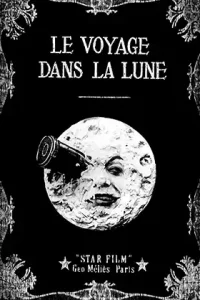To The Moon and Beyond! How Méliès' 'A Trip to the Moon' (1902) Launched Cinema into the Stratosphere of Imagination!
In the nascent, flickering dawn of cinema, when most filmmakers were simply documenting reality or staging brief vaudeville acts, a true wizard emerged from behind the proscenium arch to unleash the boundless potential of the moving image. Georges Méliès, a former magician, understood something fundamental: cinema was not just a recording device; it was a magical canvas, a dream machine capable of transporting audiences to impossible worlds. His groundbreaking film, A Trip to the Moon (1902), or Le Voyage dans la Lune, stands as an absolutely monumental achievement, not merely a quaint relic, but a foundational text in the history of science fiction, special effects, and narrative filmmaking itself. It was the first true cinematic journey into outer space, a visually inventive spectacle that proved film could capture the wildest flights of human imagination, paving the way for every fantasy, sci-fi epic, and special effects marvel that would follow. It is, without hyperbole, the rocket that launched film into its own unique orbit.
The film's delightful, if rather unscientific, premise follows a group of eccentric astronomers who, in a flash of ingenious (and entirely impractical) brilliance, decide to travel to the Moon. Led by the jovial Professor Barbenfouillis (Georges Méliès himself), they construct a massive cannon and climb into a bullet-shaped capsule, which is then hilariously fired directly at the lunar surface. What follows is an utterly charming and often whimsical adventure: the capsule famously lands smack-dab in the eye of the Man in the Moon (an iconic image), and the intrepid explorers discover a fantastical, alien landscape populated by the Selenites, agile, insect-like inhabitants of the Moon. Their attempts to explore and interact with this new world lead to predictable, yet delightful, chaos, culminating in a daring escape and a splashdown back on Earth, celebrated as heroes.
Georges Méliès' genius as a director and illusionist is on full, glorious display throughout A Trip to the Moon. He pioneered numerous special effects techniques – stop-motion, multiple exposures, dissolves, and elaborate theatrical set design – all meticulously crafted to create a truly magical spectacle. The film is a masterclass in visual storytelling, relying heavily on expressive pantomime and stunning hand-painted color (in some versions) to convey its narrative without the need for intertitles (though some versions included them). The moonscape is a wonder of theatrical ingenuity, and the Selenites are charmingly imaginative creations. Every frame bursts with creativity and a sense of childlike wonder, showcasing Méliès' unique ability to blend his magical background with the burgeoning technology of cinema, enchanting audiences with illusions that, even over a century later, retain their charm and inventiveness.
A Trip to the Moon was an enormous international success, solidifying Méliès' reputation as the "Father of Special Effects" and proving the global appeal of narrative cinema. While it was plagued by widespread piracy (especially in the US by Thomas Edison's company), which unfortunately robbed Méliès of much of his potential profit, its influence was undeniable. Georges Méliès starred as Professor Barbenfouillis, alongside Bleuette Bernon as Phoebe (the Star) and other uncredited cast members as the Selenites and astronomers. This short film, running approximately 14 minutes (at 16 frames per second), remains a cornerstone of film history, revered for its imagination, its technical innovation, and its timeless spirit of adventure. It's a whimsical, groundbreaking journey that reminds us that cinema's true magic began with a rocket to the eye of the Moon.
Director: Georges Méliès.
Cast: Georges Méliès as Professor Barbenfouillis, Bleuette Bernon as Phoebe (the Star), and various uncredited actors as the other astronomers and Selenites.
Special Info/Trivia: This film is considered the first science fiction film and a pioneering work in special effects cinema. It famously features the iconic image of the rocket landing in the eye of the Man in the Moon. The film was based loosely on Jules Verne's novels From the Earth to the Moon and H.G. Wells' The First Men in the Moon. It was a huge international success but was heavily pirated, leading to financial difficulties for Méliès. Its runtime is approximately 14 minutes at 16 frames per second.

